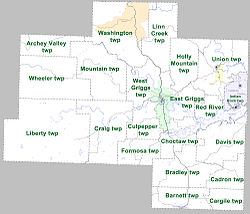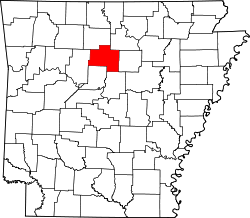Van Buren County | |
|---|---|
Clockwise from top: Van Buren County Courthouse in downtown Clinton, Middle Fork of the Little Red River Bridge, Greers Ferry Lake at Fairfield Bay, a hill near Bee Branch | |
 Location within the U.S. state of Arkansas | |
 Arkansas's location within the U.S. | |
| Coordinates: 35°36′01″N92°29′28″W / 35.600277777778°N 92.491111111111°W | |
| Country | |
| State | |
| Founded | November 11, 1833 |
| Named after | Martin Van Buren |
| Seat | Clinton |
| Largest city | Clinton |
| Area | |
• Total | 724 sq mi (1,880 km2) |
| • Land | 708 sq mi (1,830 km2) |
| • Water | 16 sq mi (41 km2) 2.2% |
| Population (2020) | |
• Total | 15,796 |
• Estimate (2024) | 16,152 |
| • Density | 22.3/sq mi (8.61/km2) |
| Time zone | UTC−6 (Central) |
| • Summer (DST) | UTC−5 (CDT) |
| Congressional district | 2nd |
| Website | www |
Van Buren County is a county located in the U.S. state of Arkansas. As of the 2020 census, the population was 15,796. [1] The county seat is Clinton. [2] The county was formed on November 11, 1833, and named for Martin Van Buren, President of the United States, who was Vice President at the time of the county's formation. Van Buren County was a dry county until November 3, 2020, as the county residents voted to make it a wet county. Van Buren County, not be confused with the city of Van Buren, which is located approximately 100 miles to the west in Crawford County just north of Fort Smith.







